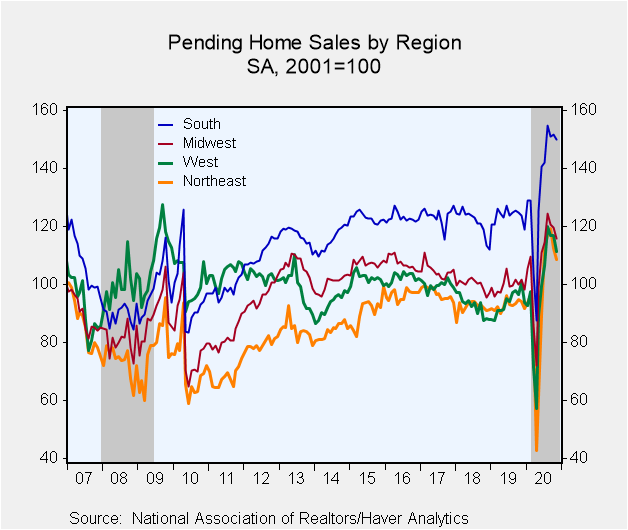 Global| Dec 30 2020
Global| Dec 30 2020U.S. Pending Home Sales Post the Third Consecutive M/M Fall in November
Summary
• Pending home sales fall for the third straight month. • Sales drop in all the major regions. Pending home sales fell 2.6% (+16.4% y/y) in November, the third consecutive m/m fall, after a 0.9% drop in October, according to data [...]
• Pending home sales fall for the third straight month.
• Sales drop in all the major regions.
Pending home sales fell 2.6% (+16.4% y/y) in November, the third consecutive m/m fall, after a 0.9% drop in October, according to data released by the National Association of Realtors (NAR). The index level was at 125.7 (2001=100), an all-time high for November, down slightly from 129.1 in October but up impressively from a recent trough of 69.0 in April. The November m/m fall was mainly due to the shortage of inventory and fast-rising home prices.
Pending home sales dropped in all the major regions of the country in November. Sales in the Northeast fell 3.3% (+15.3% y/y) after a 5.9% drop. Sales in the Midwest slid 3.1% (+14.1% y/y), the third consecutive m/m slide, after a 0.7% decline. Sales in the South fell 1.1% (+21.3% y/y), reversing a 0.5% gain. Sales in the West decreased 4.7% (+10.4% y/y) following being unchanged.
The pending home sales index measures sales at the time the contract for the purchase of an existing home is signed, analogous to the Census Bureau's new home sales data. In contrast, the National Association of Realtors' existing home sales data are recorded when the sale is closed. In developing the pending home sales index, the NAR found that the level of monthly sales contract activity leads the level of closed existing home sales by about two months. The series dates back to 2001, and the data are available in Haver's PREALTOR database. Mortgage interest rates from the Mortgage Bankers Association can be found in the SURVEYW database.
| Pending Home Sales (SA, % chg) | Nov | Oct | Sep | Nov Y/Y % | 2019 | 2018 | 2017 |
|---|---|---|---|---|---|---|---|
| Total | -2.6 | -0.9 | -2.0 | 16.4 | 1.1 | -4.1 | -0.8 |
| Northeast | -3.3 | -5.9 | 2.0 | 15.3 | 0.8 | -5.0 | 0.6 |
| Midwest | -3.1 | -0.7 | -3.2 | 14.1 | -0.3 | -4.6 | -2.5 |
| South | -1.1 | 0.5 | -2.4 | 21.3 | 1.8 | -1.9 | 0.6 |
| West | -4.7 | 0.0 | -2.6 | 10.4 | 1.3 | -7.3 | -2.5 |
Winnie Tapasanun
AuthorMore in Author Profile »Winnie Tapasanun has been working for Haver Analytics since 2013. She has 20+ years of working in the financial services industry. As Vice President and Economic Analyst at Globicus International, Inc., a New York-based company specializing in macroeconomics and financial markets, Winnie oversaw the company’s business operations, managed financial and economic data, and wrote daily reports on macroeconomics and financial markets. Prior to working at Globicus, she was Investment Promotion Officer at the New York Office of the Thailand Board of Investment (BOI) where she wrote monthly reports on the U.S. economic outlook, wrote reports on the outlook of key U.S. industries, and assisted investors on doing business and investment in Thailand. Prior to joining the BOI, she was Adjunct Professor teaching International Political Economy/International Relations at the City College of New York. Prior to her teaching experience at the CCNY, Winnie successfully completed internships at the United Nations. Winnie holds an MA Degree from Long Island University, New York. She also did graduate studies at Columbia University in the City of New York and doctoral requirements at the Graduate Center of the City University of New York. Her areas of specialization are international political economy, macroeconomics, financial markets, political economy, international relations, and business development/business strategy. Her regional specialization includes, but not limited to, Southeast Asia and East Asia. Winnie is bilingual in English and Thai with competency in French. She loves to travel (~30 countries) to better understand each country’s unique economy, fascinating culture and people as well as the global economy as a whole.








